|
Contents
(Within the text click a heading to return here)
- Prelude to Broadcasting
- The Microphone Entertains
- Keeping the Ether Undefiled
- Dawn in America
- Commonn Sense and Compromise
- Enter the BBC
- The BBC Stamp
- A Start to Setmaking
- The Crystal and the Valve
- Lads in Small Back Rooms
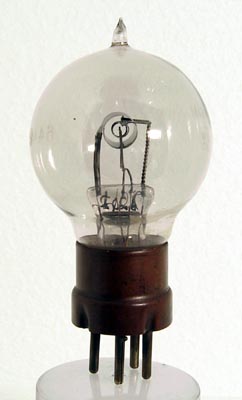 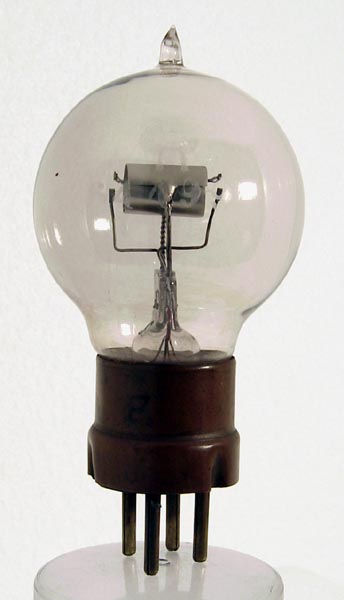 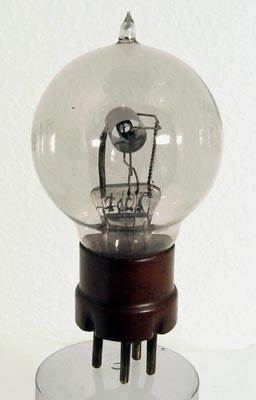
An example of the 'R' type made in the UK circa 1918
When broadcasting began, early in the 1920s, radio communication had been established for over twenty years, as 'wireless telegraphy': a means of sending Morse code that was used mostly where wires and cables were not available, as when ships were involved. Speech transmission was impracticable; 'spark' transmitters predominated, and attempting to impress speech onto their coarsely structured waves was like trying to print a newspaper on a roll of stair-carpet.
However, transmitters did exist that radiated continuous waves, and as early as 1906 R A Fessenden, a Canadian engineer working in America, transmitted several programmes of speech and music from Brant Rock, Massachusetts, using a special high-frequency alternator to generate an 80kHz wave.
Unsuspecting ships' operators who picked up the signals were astounded to hear voices and instruments over their headphones, and Fessenden deserves his place in the history books as the first broadcaster. But with the technology of that period, broadcasting was well short of practicability; to take just one example, if you got too close to Fessenden's microphone it scorched your lips.
'Radio telephony' became practicable through the perfecting of the thermionic valve during the 1914-18 war. The presence of residual gases made early valves unreliable and short-lived, but in 1913 an American scientist, Irving Langmuir, described how to achieve a near perfect vacuum, and early in the war French military scientists applied his techniques to producing a successful three-electrode triode valve that came to be known as the 'R' valve when it was produced in the UK.
In some ways resembling a light-bulb, it was mass-produced in electric-lamp factories, and by 1918 one French factory was making 1,000 valves a day. From 1916 the valve was also made in Britain, at the Ediswan, BTH and Osram lamp factories.
When the war ended large stocks of R valves were disposed of through the 'surplus' market and became the mainstay of amateur experimenters' receivers. People are on record as having foreseen before the end of the war that radio telephony could enable entertainment to be dispensed to the general public. In America David Sarnoff, later to head the Radio Corporation of America, envisaged a transmitter radiating a variety of programmes to receivers that would be ''...designed in the form of a simple 'Radio Music Box', and arranged for several different wavelengths...''
Arthur Burrows, to be involved in British broadcasting from its earliest preliminaries, made a similar prophecy, and was apprehensive that intervals in the programme might be 'filled with audible advertisements ...on behalf of somebody's soap or tomato ketchup...'
The Marconi Company, which dominated the British radio industry, was steeped in a tradition of point-to-point communication for utilitarian purposes, and the concept of broadcasting came more easily to amateur radio enthusiasts. As war-time restrictions were relaxed, pre-war amateurs were joined by men who had encountered radio in the services and now took it up as a hobby; radio telephony began to take over from wireless telegraphy as the main interest. Amateurs had to be licensed by the Post Office, who had absolute control over radio communication. Licences to operate receivers were granted fairly freely but transmitters, restricted to a power of ten watts, could be operated only by those who could 'satisfy the Post Office that their qualifications, apparatus, knowledge of the subject and objects, are sufficiently good to justify the grant.' Those objects, the Post Office told them, should be 'scientific research or general public utility', and music should be transmitted only for test purposes. But it was only natural for the more extrovert to enliven their transmissions by reading out amusing newspaper articles and playing gramophone records or even musical instruments, to the delight of their listeners.
In the field of professional radio communication, too, entertainment was beginning to be transmitted, though not yet with broadcasting in view. Early in 1920 the Marconi Company began transmitting speech from Chelmsford on 2,750 metres, to test the long-distance propagation of radio telephony. When the engineers tired of reading from Bradshaw's railway timetable and substituted records, and recitals by local musicians, reports of reception increased dramatically, both from amateurs and from ships' operators.
The newspaper proprietor Lord Northcliffe saw a unique opportunity for publicity, and sponsored the transmission of a 30 minute recital by Dame Nellie Melba on 15 June, giving it heavy coverage in his paper the Daily Mail. This event generated great interest, with reception reported from all over Europe, and further transmissions of music from Chelmsford took place throughout the summer of 1920. Though their overt purpose remained the promotion of radio telephony for point-to-point communication, it is safe to assume that by this time Arthur Burrows, now Marconi's Publicity Manager, was not the only person in the company with a vision of broadcasting.
As the transmissions continued into the autumn of 1920, however, they were increasingly criticized, particularly by high-ranking officers in the armed forces, for interfering with legitimate services. A newspaper article related how the pilot of a Vickers Vimy'...was crossing the channel in a thick fog and was trying to obtain weather and landing reports from Lympne. All he could hear was a musical evening...' No doubt the critics were in part expressing a priggish objection to the very idea of using high technology for mere entertainment, but congestion of the radio spectrum was a valid cause for concern. The spectrum is an inherently limited natural resource, and of the many thousands of megahertz in use today only the lowest one or two could be exploited with the technology of 1920; moreover, transmitters had to be widely separated in frequency because of the poor selectivity of contemporary receivers. The Post Office was obliged to act. It authorized each transmission from Chelmsford individually, as a demonstration; it now stopped issuing authorizations, and granted only a handful during the whole of 1921.
This was a severe blow to the amateurs, who relied upon high-quality transmissions of known power and wavelength, in order to check and calibrate their equipment. Broadcasts with no purpose other than entertainment were made by a Dutch station, PCGG, which could be picked up in many parts of Britain despite technical eccentricities that prevented its use for calibration purposes. The station was run by one Hans Idzerda to promote sales of his company's crystal sets and components, and from April 1920 it radiated regular concerts on Sunday afternoons and on Monday and Thursday evenings, with the Dutch announcements repeated in French and English. A number of telegraphic signals of general interest were also available at this period. Time signals had been radiated from the Eiffel Tower since 1910, and were also available from Lyons and from Nauen, near Berlin; for those able to read Morse, there were news transmissions by the principal press agencies, and meteorological reports and weather forecasts from the Marconi station at Poldhu, in Cornwa1l.
In March 1921 there were 150 amateurs licensed to transmit and another 4,000 to receive only. What was to be heard over the air undoubtedly enhanced the pleasure of experimenting, but it fell a long way short of being viable as entertainment, and there was little demand for ready-made receivers. The first valve receiver offered to the public, in fact, was not intended primarily for entertainment. It was made by a major electrical manufacturer, the British Thomson- Houston Company (BTH). One of their engineers, R C Clinker, was a horological expert who in 1912 had built a crystal set to receive the Eiffel Tower time signals, and in 1915 had made what has been claimed to be Britain's first high-vacuum triode.
After the war Clinker replaced his crystal set with a simple two-valve portable receiver, which was marketed from early in 1920. A brochure dated February 1921 lists its possible applications. In addition to the reception of time signals, these included instructional purposes in Technical Colleges and the generation of radio-frequency oscillations for laboratory use.
Complete receivers were also available during 1921 from Burnham and Co. and from L McMichael Ltd both early entrants to the wireless business through the enterprise of well-to-do enthusiasts whose voices and call-signs were familiar to amateurs in the London area. Burnham and Co's main business was the manufacture of enamelled advertising signs, but the founder's eldest son, Walter Witt Burnham, had become interested in wireless, and in 1918 his father had reluctantly agreed to his opening a radio department, although considering it a frivolous distraction. The company's premises were at Deptford, in south-east London, so Walter coined the name 'Burndept' for his components and receivers. Leslie McMichael, trained as an electrical engineer but at one time earning his living as a laundry manager, 10 had been at the heart of the amateur radio movement since 1913, when he was a founder of the London Wireless Club. This was soon renamed the Wireless Society of London, and in 1922 merged with the other societies to become the Radio Society of Great Britain (RSGB). McMichael served in the Wireless Instructional Section of the Royal Flying Corps during the war, formed a private company, L McMichael Ltd, in 1920, and sold war-surplus equipment to experimenters from a stall outside his home in West Hampstead.
Meanwhile, in the more permissive climate of the United States, broadcasting had already begun. An engineer at Westinghouse's Pittsburgh plant, Dr Frank Conrad, who operated an amateur transmitter in his garage, would sometimes leave a phonograph playing in front of the microphone while he made adjustments. Other amateurs wrote asking for more, and he began regular recitals. This far the story could equally well have taken place in Britain, but only this far. On 29 September 1920 a local department store advertised receivers to pick up Conrad's 'Air Concerts' and sold out his stock in two weeks, whereupon Westinghouse's vice-president, Harry P Davis, encouraged Conrad to build for the Company a larger transmitter, which was allocated the callsign KDKA. At the same time, receivers capable of being operated by the non-technical were designed and built. On 2 November, within six weeks of the department store's advertisement, KDKA began broadcasting, giving the results of the presidential election, and entered history alongside the Dutch station PCGG, each claimed by its supporters to have been the world's first non-experimental broadcasting station. KDKA's success initiated a chain reaction, and by 1922 American broadcasting was exploding into a chaos of interfering stations.
Throughout 1921 Britain lay under the Post Office's almost total ban on radio-telephony broadcasts. However, the amateurs now proved themselves an effective pressure group; though a number of them were, like Burnham and McMichael, commercially involved in radio, collectively they were considered as having no commercial axe to grind. In December, sixty-four wireless societies representing amateurs from all parts of Great Britain submitted to the Post Office a petition nicely calculated to achieve its end without offending official susceptibilities.
In the midst of proclaiming amateur radio's scientific, educational, economic and strategic importance, it slipped in the admission that to keep members interested 'it is necessary to make the occupation interesting and even entertaining; hence the need for a wireless telephonic speech and even music.' As a result, the Post Office allowed the Marconi Company to include fifteen minutes of telephony in the weekly half-hour already being radiated as a calibration transmission for amateurs but hitherto restricted to Morse.
However, for three minutes in every ten the engineers still had to suspend transmission and listen on their own wavelength, so that they could be instructed to close down if they were interfering with a government or commercial station.
The spring of 1922 brought a dramatic change in official attitude. Quite suddenly the question was not whether a weekly fifteen minutes of telephony could be allowed, but how a full-time nationwide broadcasting service could best be brought about. News was reaching Britain of spectacular growth in America, creating a seemingly insatiable demand for receivers and components. British companies were understandably eager to promote a similar bonanza here, and by the end of May the Post Office had received 23 applications for permission to start broadcasting.
In the face of this pressure, and of the growing public awareness that Britain was being left behind, a negative official policy would no longer serve. It was time for Britain to show the world how to organize broadcasting in an orderly manner.
On 18 May 1922 the Post Office met representatives of eighteen companies, and told them to come up with proposals for a co-operative scheme for broadcasting, or at most two such schemes; all the companies were in either the wireless or the electrical business, the Post Office having already decided not to allow broadcasting by other organizations such as newspapers and retail stores. A few days later the companies appointed a small committee to take part in the subsequent negotiations, comprising representatives of six major companies and one minor one, the latter included at the Post Office's suggestion to represent the interests of all the smaller firms. The 'big six' were the Marconi Company, Metropolitan-Vickers, Western Electric, GEC, BTH and the Radio Communication Company, this last being entirely engaged in marine radio. The minor company chosen was Burndept Limited, Burnham & Co's radio department now hived off as a separate company, represented by its Chief Engineer and Works Director, Lt-Com C Frank Phillips. Witt Burnham's early entry into the receiver business had secured him a seat at the top table.
For five months, while press and parliament grumbled at the delay, Post Office and committee struggled to reconcile conflicting interests. The Marconi Company wished to build all the transmitters itself and was unwilling to license competitors to use any of its 152 patents; the manufacturers were only prepared to guarantee a service for two years, but the Post Office wanted five; there was haggling over how broadcasting was to be paid for. It was not until 18 October 1922 that matters were sufficiently settled for a meeting to be held at which firm proposals were put to the industry for approval. The wireless industry had already expanded in anticipation of broadcasting, and over 200 firms sent representatives.

A view of the 2LO aerial on the roof of Selfridges in Oxford Street London in 1926
A company to be known as the British Broadcasting Company (BBC) was to be set up, having eight stations (six with Marconi transmitters) located in the main centres of population. Capital would mostly be subscribed by the 'big six' who would also provide further funding if necessary, but any bona fide British manufacturer or retailer could become a member of the Company by purchasing one or more £1 shares; (by May 1923, membership reached 564).
Listeners would buy an annual licence costing 10s (50p) and only permitting the use of receivers made by members of the BBC; the receivers were to carry a distinctive label. Half the licence-fee would go to the BBC, and receivers would carry two tariffs. One, charged upon the receiver's various components, would go to the BBC; the other, amounting to 12s 6d (62.5p) on each valve-holder, would go to the Marconi Company as a royalty, in return for allowing their patents to be used.
To protect the infant industry from imports, against which British goods would have been uncompetitive at current exchange rates, members of the BBC would be confined to British-made apparatus for a period of two years. The BBC was not intended to be a direct
source of profit to its shareholders, so the annual dividend was fixed at 7.5% and no capital gain was allowed.
The proposals were agreed, and on 14 November 1922 the BBC went on the air from 2LO in London, to be joined the next day by 2ZY in Manchester and 5IT in Birmingham. By the following October all eight of the planned stations were in operation, each producing its own programmes, and about half the population could pick up a signal strong enough to operate a crystal set. By the end of 1924 the figure was up to 70%, with the opening of a ninth 'main' station, in Belfast, and also of 11 low-power 'relay' transmitters serving large towns not covered by the 'main stations'. In July 1925 the BBC opened a high-powered long-wave transmitter at Daventry, itself covering 55% of the population of Great Britain, and bringing 85% of the population within 'crystal range' of at least one transmitter.
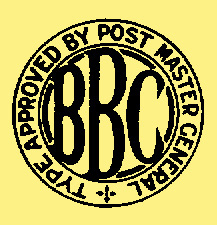 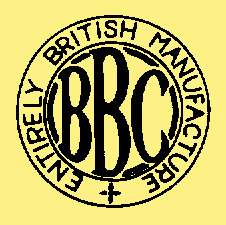 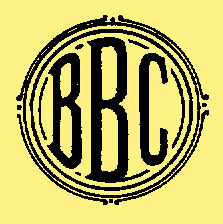
Three BBC stamps were used in the early days of broadcasting. The first, shown on the left, featured both BBC and Post Master General identification. This stamp was used from 1st November 1922 until September 1924. On valves this symbol was normally etched into the glass envelope and gives a good indication of the date of origin. All sets had to be submitted to the Postmaster General for 'Type Approval' and if granted the sealed pattern set had to be maintained without alteration by the manufacturer.
The second stamp, shown in the centre above, celebrated the BBC and the fact that the product was Entirely British Manufacture. This stamp was employed between September 1924 and 1927 and was used concurrently with the BBC trademark stamp that is illustrated on the right. The latter was little used.
On 1st October 1923 royalties were abolished for valves, headphones and loudspeakers. Additionally the official testing of set designs for the ability of the reaction control to cause oscillations to radiate from the aerial was abolished. New sets were still tested but for compliance with the band of frequencies to be received. Manufacturers were freed form the restrictions on earlier sealed sets and could thus introduce modifications to their designs without further official approval.
On 1st July 1924 all royalties on BBC stamped items were abolished. From this date anyone who had a Broadcast Licence could purchase receiving sets from any British manufacturer, and not just those that formed part of the BBC. BBC firms, however, were still required to display the BBC stamp on their products and seek approval on their equipment from the Post Master General.
On 1st January 1925 the stamp regulations were abolished, and BBC member companies were no longer compelled to display the stamp on their products. As the stamp gave status, its use was slow to end but by the end of 1927 the practice of using the BBC stamp had died out.
In 1935 Wireless World remarked that 'the radio industry' was a fairly recent term and that in the early days of broadcasting one always spoke, with some justification. of 'the wireless trade'. Initially that trade was largely in components and home-construction kits, but it is convenient to consider ready-built receivers first.
Although valve receivers played a more prominent role in the story of the emergent radio industry, crystal sets were to outnumber them until 1927, and to that extent may be said to have dominated the early years of broadcasting. A good one could be bought for £2 or £3, or easily built at home for less and cost nothing to run; a good valve set cost upwards of £15 and needed a new high-tension (HT) battery to be bought every few months, as well as weekly recharging of the two or three lead-acid accumulators that provided the low tension (LT) current heating the valves. The valves themselves, moreover, required fairly frequent replacement; the life expectancy of an R valve was only 100 hours. Thus for the less affluent majority it was a crystal set or nothing. Since the set contained no source of energy, the only power available to operate its headphones was that minute fraction of the transmitted energy intercepted by its aerial, and even with lOO' of wire rigged as a 70' horizontal top and a 30' down-lead (the maximum dimensions permitted) satisfactory reception was possible only within 15-20 miles of a high-power transmitter. Yet until it provided a community with a signal adequate for crystal-set reception the BBC derived little income from it, and was failing the poorer sections of its population.
Under favourable conditions a crystal set could operate two or three pairs of headphones, but it was difficult to combine 'listening in' with conversation. The set consisted typically of a tuned circuit connected to the aerial and a metal-to-mineral contact that allowed current to pass through it in one direction but not in the other, thereby recovering the radio wave's audio content. In most models this crucial, but unstable, contact was achieved by the tip of a springy metal 'cat's whisker' pressing against a fragment of crystalline mineral, and achieving the best performance depended upon applying the right pressure to the right spot; fiddling with the cat's whisker might improve the contact, but at the cost of temporarily losing the programme.
The valve receiver was free of this quirk, and had further advantages over the crystal set: it could operate a loudspeaker, it could amplify weak signals and it could separate stations better. Thus, as well as bringing broadcasting to those not within crystal-set range of a transmitter, in many areas it offered a choice of programmes, since the BBC's main stations originated almost all their own material. And, wherever one lived, the valve receiver offered the exotic prospect of exploring Europe from one's fireside, at a time when many people had never heard a foreign language spoken, and familiarity had not yet dulled the impact of a Parisian accordion or a Tyrolean band.
But there were penalties besides price to be paid. Receiver and loudspeaker usually produced more distortion than crystal set and headphones did, while sensitivity and selectivity almost always relied on using a 'reaction' control to feed back part of a valve's output to its input. Increasing the amount fed back improved performance, inevitably tempting the user to cross the threshold at which the valve's amplification became literally infinite, thereby converting the valve from an amplifier to an oscillator and the set from a receiver to a transmitter. This produced howling noises in other receivers tuned to the same station, possibly for a mile or more around. Oscillation became sufficient of a nuisance to cause the BBC's ebullient Chief Engineer, P P Eckersley, to come on the air: Is this fair? Is this British? Don't oscillate. Please don't oscillate. Don't do it. The problem had, in fact, been anticipated before broadcasting began, and initially a specimen of each model made by a BBC company had to be sent to Post Office headquarters for approval, to ensure that any reaction employed was incapable of producing oscillation in the aerial circuit; if approved, the pattern set was sealed and returned to the manufacturer, who had to preserve it intact and obtain sanction for any change in design. Inevitably this restriction compromised performance and, moreover, could not be imposed on home-constructed sets, so it was quietly dropped. The listener who was content to hear only his local station and could receive it satisfactorily on a crystal set could obtain loudspeaker reception by adding a low-frequency amplifier, which was much more docile than circuits using valves at radio frequencies; alternatively 'valve-crystal' receivers were available, offering this combination in a single unit.
Early receivers, whether crystal or valve, were rudimentary, and the beginning of broadcasting caused many back-street factories to spring up, where a few hands assembled bought-in components. There was an extreme example of this in Leeds, where the spectacular demand created in 1924 by the opening of a local transmitter sent a young entrepreneur off on a trip to London to establish sources of parts for the manufacture of crystal sets in a small workroom behind his electrical shop. With a partner and two or three youths he made sets up to sell at 30s (£1.50) including aerial and headphones, while customers queued up to buy sets as they were completed. Fifty sets a day were produced and each yielded a gross profit of 10s (50p), enabling the partners to finance a well-stocked components business serving home constructors.But after a year or so the market became saturated, demand suddenly collapsed, and they were glad to get rid of their stock, for about a quarter of what it had cost them, to people similarly exploiting a newly opened transmitter in the East Midlands.
|